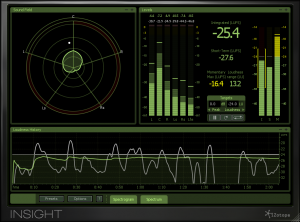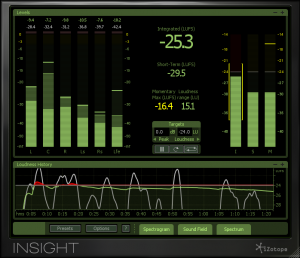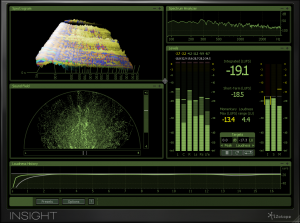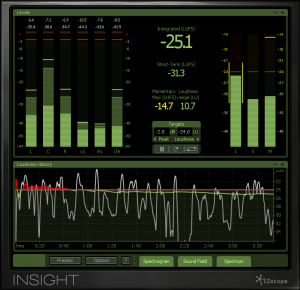Review: iZotope Insight (Essential Metering Suite) by Zach McNees
If you work with audio primarily ‘in-the-box,’ you know that your DAW is only as powerful as the plugins you stock it with. EQs, compressors, reverbs, effects and synths no doubt make up the vast majority of your toolset. But metering plugins are an equally crucial component of the modern DAW, especially as modern engineers branch out to work on a wider variety of projects – including audio post-production, as I often do.
iZotope is known for comprehensive utility software products like the RX “complete audio repair toolkit” and the Ozone “complete mastering system”. Their plug-ins have also become synonymous with incredible sound, unparalleled features and flexibility. So when they announced their new product would be dedicated entirely to metering tools, I knew it would be something I needed to check out.
TECH SPECS: iZotope’s Insight is a Native-only plugin for MAC and PC and retails for $499. Formats are RTAS, AAX, AudioSuite, VST, VST3, Audio Unit and DirectX. Insight is compatible with both 32-bit and 64-bit hosts like Pro Tools 7.4 and above, Avid Media Composer, Nuendo, Cubase, WaveLab, Logic, Edius Pro 6.5, Final Cut Pro X (Mono/Stereo only), Audition, Premiere Pro (Surround only), Sonar, Reaper, Digital Performer, Sound Forge Pro, Vegas Pro, and many more.
WHAT IT DOES: Insight is a complete suite of metering tools packaged in one plugin. The suite is comprised of Levels, Loudness History, Sound Field, Spectrum Analyzer, and Spectrogram to form a total metering and on the fly audio evaluation set.
IN USE: A typical week for me usually means switching back and forth several times between music and post-production projects at my facility. Needless to say, Insight got a full workout over the past few weeks on a number of projects, all requiring different sets of metering tools. Insight provides an enormous wealth of features and possibilities under its hood. Let’s take a look at some of the most important features!
Insight is broken up into five main audio analysis categories: Levels, Loudness History, Spectrogram, Sound Field and Spectrum. Each of these tools can be engaged or disengaged within Insight and exist as tabs at the bottom of the plugin if not in use. Once engaged, the window for each tool set can be adjusted for size allowing the user to configure Insight precisely for the data sets most useful in any given session. Any tool open within Insight can also be made “full screen” within the plugin by selecting the + to open it up and the – sign to return to the multi-window view.
In the post-production world, it’s all about hitting your marks so to speak. Insight provides all the necessary data the engineer needs to begin working and analyzing data on the fly very quickly.
As with most metering plugins, it’s recommended that you place Insight last in the chain on your final mix bus so that it’s capturing the whole project. Once Insight is opened, the first window to pop up is the presets window. This will come as no surprise to veteran iZotope users as all of their plugins tend to have an excellent selection of built-in preset capabilities.
Insight presets are grouped independently for post-production and music. Post-production presets include multiple configurations of the loudness meter and other available options such as the history graph already setup for broadcast standards in the USA, EU and Japan. There are also presets available for console and handheld video game loudness metering as well as a folder of pure audio analysis options. Music production presets include Stereo Mixdown, Stereo Analysis, Podcast Production, Headroom Warning and many other music specific packages to help fine tune your mix.
For post-production I begin by selecting the Loudness Meter with History Graph USA preset. Insight is setup brilliantly to provide a great deal of data analysis without seeming overly complicated or messy. Let’s take a look at each available tool for Insight:
Levels
At the bottom of the levels section is the “Targets” setup, which allows the user to input specified loudness values they need to stay under for their session. This is where any broadcast standards such as a -10dB ceiling and a typical -24dB dialogue level would be input. After setting loudness targets, any audio which exceeds the threshold will display as red in the plugin to alert the engineer of potential problems. Below the target values are key features such as Start/Pause, Reset and Continuous Calculation.

Set your loudness targets and any audio which exceeds the threshold will display as red in the plugin.
Start/Pause: Allows toggling of the overall calculation of the plugin effectively acting as a pause button for Insight.
Reset: Allows the user to instantly reset all captured measurements within Insight.
Continuous Calculation: When engaged, Continuous Calculation allows Insight to essentially chase your DAW. In short, this means Insight will process normally when your DAW is playing back and will pause itself from continuous calculation when your DAW is stopped. This is a crucial feature that keeps Insight from including the time your DAW is paused into the integrated loudness calculations and thus providing the engineer with a surgical data set of only the program data.
To the left of the Targets window are the main LR or Surround levels based on your setup configuration. To the right of the Targets window are level meters for integrated, short-term and momentary loudness. These three level meters offer a great deal of information about what’s happening in your project at any given moment.
Momentary: Labeled “M” under the meter, this measurement – as stated in the manual – is a calculation of loudness over the course of 400ms.
Short-term: Labeled “S”, this measurement is a calculation of loudness over the course of 3 seconds. Short-term is useful in monitoring immediate trends of loudness in your audio.
Integrated: Labeled “I”, this measurement is a calculation of loudness over the course of an indefinite period of time. This is an infinite average and generates a single loudness calculation for the total calculated period or program.
Above the Targets window are numerical calculations for the Integrated and Short-term levels as well as a momentary loudness max range low and high level. These provide crucial information about the exact levels happening in your program at any given moment in your program.
Loudness History
The Loudness History graph provides a graph of loudness trends over the time of your program. This is one of the most unique and useful features in the Insight package. Users can zoom in or out on both the horizontal time plane and the vertical levels plane to access a surgically focused view of a particular scene or an overview of the whole program. The Loudness History graph is useful for depicting the visual trend of your audio history.

Analyze your audio via Spectrogram, Sound Field, Spectrum and Loudness History Graph (all in one view)
As an example mentioned in the manual, if your Integrated Loudness is slowly increasing or decreasing over the course of the program, this trajectory will be immediately apparent by the green line which represents the integrated capture total. Once your program has run in its entirety, it’s easy to visualize precisely where you might need to adjust the dialogue level of your program.
The Loudness History Graph also includes Copy Data and Copy Image features. Copy data allows the user to copy the time code and numerical loudness data and export it to a spreadsheet. Copy Image simply captures a screenshot of the Loudness History Graph onto the computer’s clipboard allowing you to paste the image elsewhere or to submit with tape reports to assure compliance with loudness standards. This would also be a useful tool when comparing a track before and after mixing and mastering.
Sound Field
Sound Field is the Vectorscope section of Insight. Sound is used while mixing or mastering to monitor the overall stereo width of audio. Potential phase issues can also be monitored within Sound Field via the built in + and – phase tool. Depending on your preference, the Sound Field Vectorscope can be configured three different ways in the options menu – as a Polar Sample, Polar Level or Lissajous Vectorscope. The Lissajous Vectorscope will look immediately recognizable to anyone who’s worked on an SSL analogue console as this is the default scope for that desk. Bonus points to anyone who actually knew it was called a Lissajous Vectorscope!
Of course, the Sound Field scope can also be configured in the options window for Stereo or Surround based on the needs of your program.
Spectrogram
The spectrogram provides continuously updating 2D or 3D analysis of the frequency spectrum of your audio, allowing you to visualize frequencies as they occur over time. The 3D feature of Insight’s spectrogram allows you to inspect the analysis from many different angles.
You can also feed individual audio tracks or busses into Insight’s spectrogram through the built-in Meter Taps plugin. These individual sounds can then be viewed as a group within the Spectrogram section in ‘full screen’ mode by selecting Meter Taps. So, for example, by placing Meter Taps before and after a plugin, you could evaluate a signal before and after processing in Insight.
Spectrum Analyzer
The spectrum analyzer provides a real time display of frequencies of your audio based on their amplitude. The spectrum analyzer is a helpful tool for mixing and mastering to detect on-the-fly how different frequencies are shaping your mix in relation to their loudness. The spectrum can be viewed full range or zoomed in on the frequency plane and the loudness plane. Linear, 1/3 Octave, Full Octave and Critical bands are all optional views within the Spectrum Analyzer.
Options
One of the things that has always impressed me about iZotope is the sheer amount of control provided to the user to customize their plugin both visually and sonically. Insight proves no exception, as the options menus available are quite thorough. Inside the options window are tabs for General, I/O, Levels, Sound Field, Spectrogram and Spectrum.

You can customize Insight to display just the tools and graphs you need to reference for your session.
The General options tab provides support for the plugin’s buffer size, opacity and meter frame rate filter as well as authorization and updates information. The I/O tab allows for selecting between various surround channel configurations such as Film, SMPTE and DTS. Each of the remaining tabs inside Options provide specific options that cater to most of Insight’s tools.
Obviously, Insight is jammed packed with useful features and customizable options under the hood. What struck me immediately when opening the plugin, however, was the design. Insight has been designed brilliantly to maximize both flexibility and access to data. I was amazed at how intuitive Insight was from the first moment I began working. I selected my preset, set my Targets and began mixing my project and analyzing the results within seconds.
TO BE CRITICAL: As with many iZotope plugins, Insight does require quite a bit of CPU Usage. Out of the box with default options, Insight takes about 6% of my RTAS activity on a 2.8 Quad Core Mac Pro with 16GB of Ram. Obviously each user can expect a slightly different amount of system usage depending mostly on the number of cores available in your system and their speed. In a typical music mix running lots of plugins, I wouldn’t be completely comfortable leaving Insight open all the time as the additional 5 to 6% usage would be more than enough to overload my mix and give me the dreaded DAE error.
IN CONCLUSION: Insight is the single most comprehensive metering and audio analysis plugin I’ve ever come across! It’s extremely well designed both technically and aesthetically and works beautifully for post production, music and probably has a place in some live situations as well.
At $499, Insight isn’t likely to inspire many purchases from window shoppers. This is truly a professional-level plugin designed for experienced users. However, the $499 price point is half the price of the standard broadcast metering tool used in most post-production facilities while providing a great many more features than its closest competitor. I will not be surprised if this becomes the new standard metering tool for broadcast mixing and music production in the coming years. Well done, iZotope!
Zach McNees is a Brooklyn-based producer/engineer/mixer and live recordist who’s worked with Björk, Rob Thomas, Julia Nunes, The Gregory Brothers, Pixies, Liars and Alice Cooper. Get in touch with Zach via http://www.zachmcnees.com.
Please note: When you buy products through links on this page, we may earn an affiliate commission.







